Coronavirus Today: How will we get the vaccine?
Good evening. I’m Amina Khan, and it’s Friday, Nov. 13. Here’s the latest on what’s happening with the coronavirus, plus ways to spend your weekend and a look at some of the week’s best stories.
“The cavalry is coming.” That message from Dr. Anthony Fauci, the nation’s top infectious disease expert, came on the heels of an announcement by Pfizer that early data from clinical trials show their candidate vaccine appears to be 90% effective. Fauci said he hoped shots would be available to all Americans in April, May and June.
Can you feel the hope? The hope that we may, at some point in the near future, resume something akin to our former lives? I sure can. And with the U.S. in the throes of a surge in hospitalizations and new infections, we really needed a little good news. Bask in it. Savor that feeling, because now public health officials face the next big undertaking: how to execute the biggest vaccination effort in U.S. history.
This is going to be a challenge as multifaceted as it is massive. Officials will have to distribute hundreds of millions of doses of vaccine, prioritize who gets it first, and ensure that those who get their initial dose actually return for the crucial second dose.
Public health authorities across the nation are gearing up. Philadelphia’s health department is counting how many healthcare workers and other priority recipients would be among the first in line there. Louisiana officials are planning a remote exercise to play out different scenarios to see how the process would work. “If you get 10,000 doses, what are you going to do, versus 100,000 doses?” said Dr. Frank Welch, director of the state’s immunization program.
Officials know what’s at stake, and that they really have just one, ahem, shot to get this right. They’ll face several major challenges, including:
• Recruiting doctors, pharmacists and other kinds of providers to administer the shots. If health officials succeed in persuading nearly all Americans to get vaccinated — a challenge in and of itself — they’ll need new ways to meet that demand.
• Coming up with methods to track who has been vaccinated, and how many doses they’ve received. The more vaccines that are approved, the trickier this will get, since doses from different manufacturers can’t be mixed and matched.
• Making sure the vaccines are delivered safely and securely. As if the logistical hurdles weren’t daunting enough, consider that the Pfizer vaccine needs to be kept at minus 70 degrees as it’s moved around the country.
Of course, all of these efforts require cash — perhaps as much as $8.4 billion by one estimate. States have received far less money than they say they need for vaccine distribution — and it’s unclear if or when any more federal help is coming.
President Trump didn’t offer any funding details when he spoke from the Rose Garden on Friday to claim credit for the Pfizer vaccine’s apparent success. “No medical breakthrough of this scope and magnitude have ever been achieved this rapidly, this quickly,” Trump said. “We’re very proud of it.”
Business columnist Michael Hiltzik warns that we still have a ways to go before the first vaccine is delivered. The Pfizer trial data are promising but preliminary, and there’s certainly no guarantee that any vaccine candidate will be a home run. That’s why it’s imperative Americans keep their guard up by continuing to mask up and socially distance. (To that end, Gov. Gavin Newsom acknowledged he shouldn’t have attended a birthday dinner party at the French Laundry restaurant in Napa Valley.)
“It would be a tragedy if Pfizer’s news prompts laypersons to feel that they can now party as though it’s 2019,” Hiltzik writes.
By the numbers
California cases and deaths as of 4:58 p.m. PST Friday:

Track the latest numbers and how they break down in California with our graphics.
See the current status of California’s reopening, county by county, with our tracker.

What to read this weekend
Everybody loves an underdog: My colleague Thomas Curwen chronicles the hunt for a COVID-19 vaccine by members of an underdog laboratory: the Brooklyn-based IAVI, a nonprofit with 25 employees.
Chris Parks joined IAVI years ago in an effort to find a weapon against HIV. Now, he and his colleagues are trying to create a chimera-like benign virus with just enough genetic material from the new coronavirus to prime the immune system to attack. They’re up against deep-pocketed corporate behemoths like Sanofi, Johnson & Johnson, AstraZeneca and Merck. This thriller-style tale is fraught with uncertainties and risks that are far easier for billion-dollar pharma companies to take on.
“I’ve been around the business so long that I know things can go wrong,” Parks said. “So much of science turns out negative. Positive results are rare.”
But when it comes to stopping a global pandemic, he felt the risks were well worth the effort. Read the whole story for an inside look at the quest.
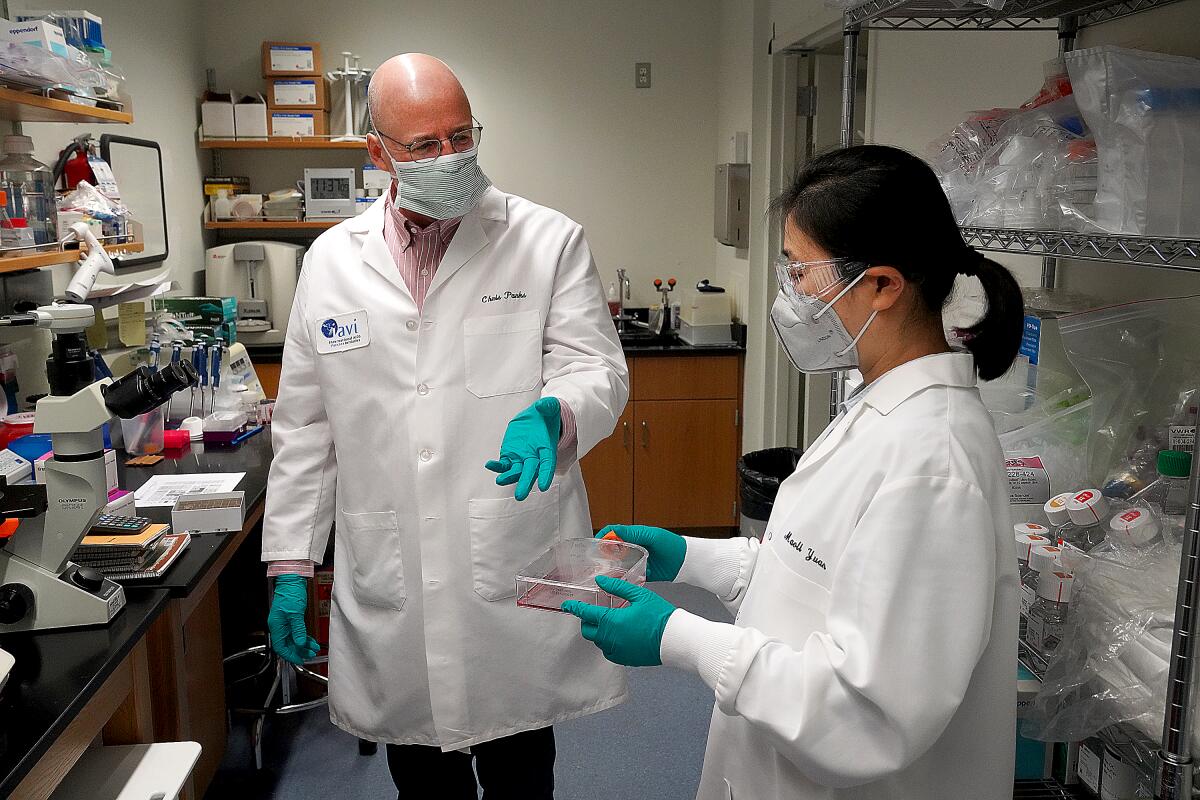
From one woman to 1 million infections: In January, Patricia Dowd came down with flu-like symptoms and had to cancel plans to attend a funeral. On Feb. 6, she was found dead in her San Jose home. The 57-year-old manager for a Silicon Valley semiconductor company is believed to be the first person to die of COVID-19 on American soil.
Back then, the coronavirus seemed to be of little import here in the U.S. But over the past 10 months, more than 1 million Californians have been infected. My colleague Soumya Karlamangla goes deep on how California got to where it is now — and what threats the coming season holds.
“Much like the promise of two-week stay-at-home orders and warm summer weather vanquishing the virus, the days of a clean narrative about California’s experience with the pandemic are far behind us,” Karlamangla writes. “The inescapability of the virus is clear, but so are California’s persistent efforts to trudge through.”
De-politicizing the mask: President-elect Joe Biden has rallied scientists and economists behind his seven-point plan to beat COVID-19. But getting more Americans to rally behind mask-wearing may be a far more difficult task.
Public health experts say this simple piece of fabric is one of the most effective defenses we have against the spread of the virus. But it has also become a potent political flashpoint, with Democrats largely supporting their use while many of President Trump’s most avid supporters refuse to wear them as an affront to personal freedom.
My colleague Noam Levy explores the sticky question of whether Biden — who has repeatedly sought to cast mask-wearing as an act of bipartisan solidarity — can persuade more Republicans to get on board.
“We could save tens of thousands of lives if everyone would just wear a mask for the next few months. Not Democratic or Republican lives — American lives,” Biden said after meeting with members of a newly formed COVID-19 advisory board Monday. “We have to do this together,” he added.
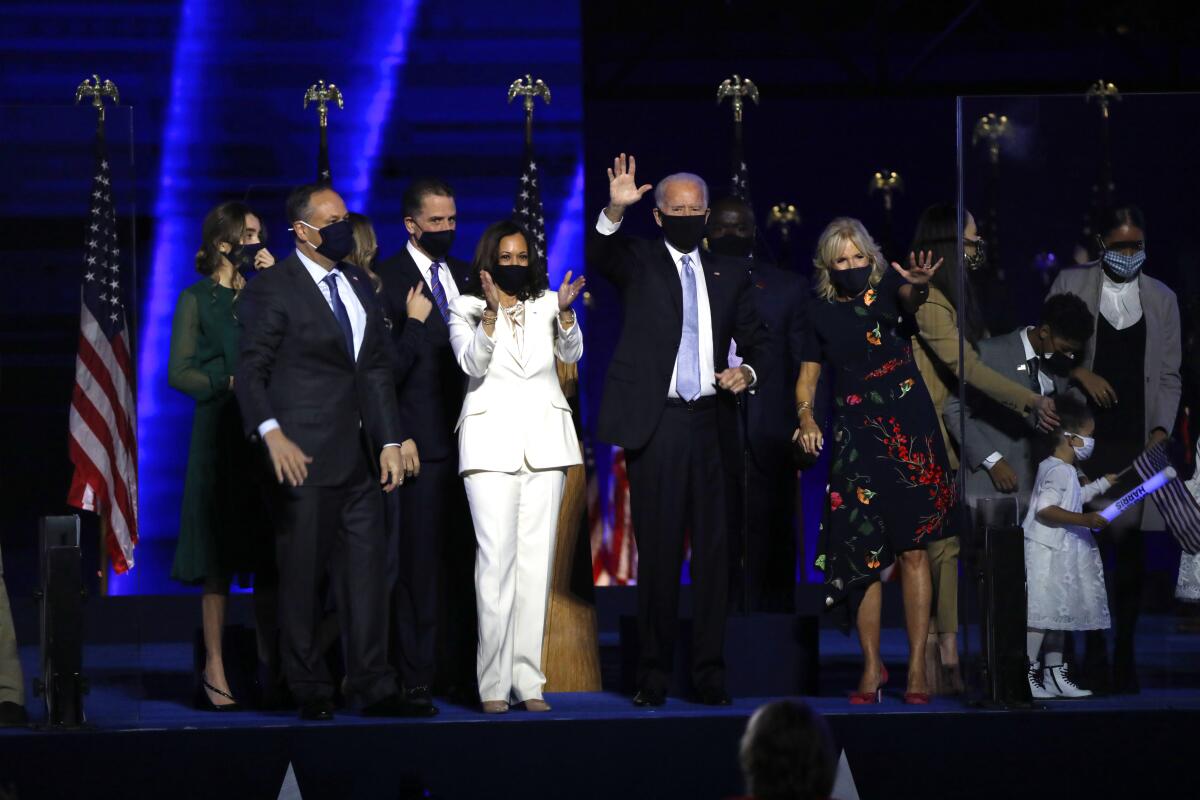
Taking one for the team: Volunteering for an unproven vaccine is not a job for the fainthearted — even those without any preexisting conditions might balk at the associated risks. But a history of colon cancer didn’t stop Dan Stepenosky from joining a clinical trial for the Pfizer-BioNTech candidate.
Since it’s a double-blind study, he can’t be sure he got the real deal or a placebo. But after learning this week that the experimental vaccine may be 90% effective, he and his daughter — who was inspired to join the trial two months after him — savored the news.
“I guess we made the right bet,” Stepenosky told columnist Sandy Banks.
Stepenosky was reluctant to tell friends and colleagues he was testing the vaccine. He got a little pushback from some, even from his radiologist brother, who thought the cancer survivor shouldn’t take unnecessary risks. But the former high school physics teacher wasn’t swayed by others’ opinions. “I believe in science and I believe in medicine, so I’m all in.”
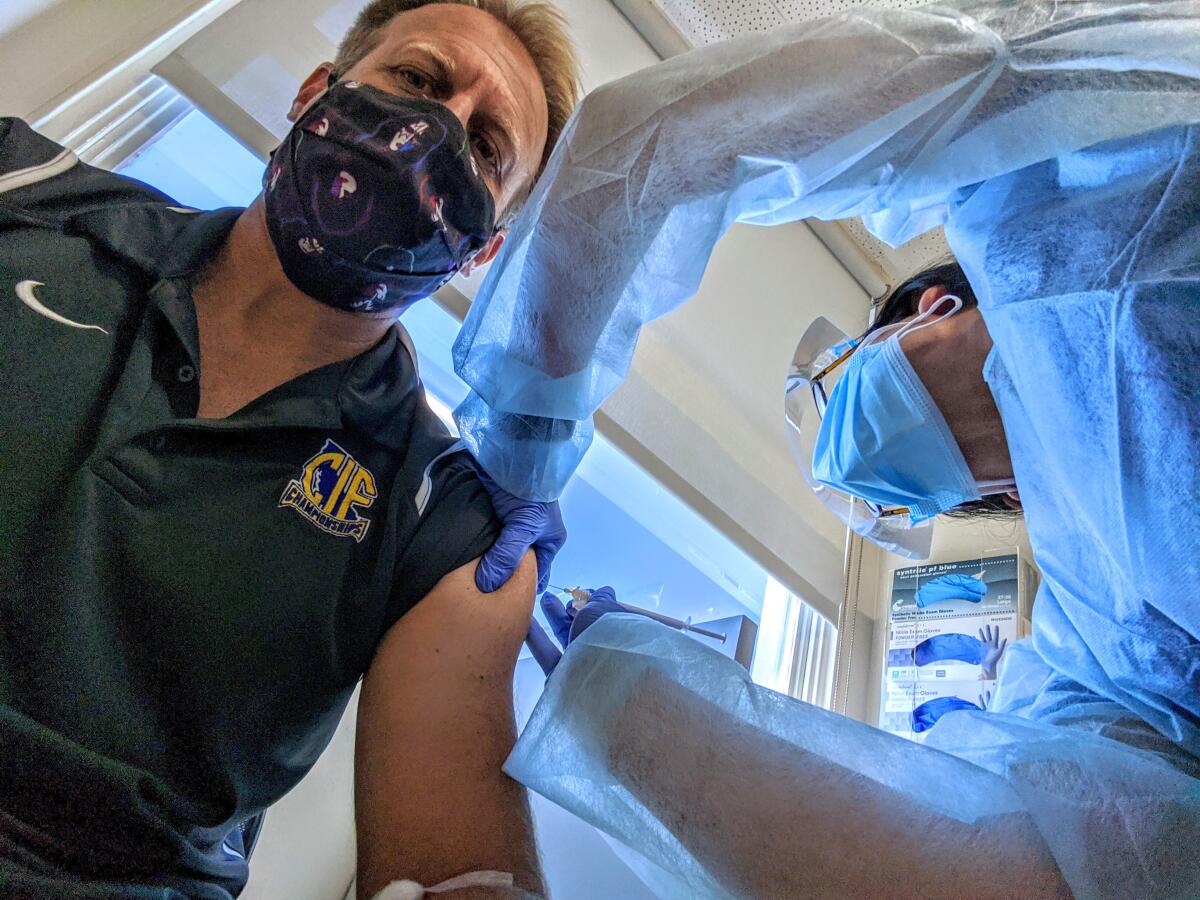
A deadly mystery, a possible solution: Almost since the pandemic began, doctors have been struggling with the apparent capriciousness of COVID-19. Why do some patients get so much sicker than others? Now, scientists believe they’re homing in on an answer. It seems that some people, particularly men, are hit harder because their immune systems are dealing with “friendly fire.”
A study last month in the journal Science found that 10% of nearly 1,000 COVID-19 patients who had developed life-threatening pneumonia had antibodies that disable key immune system proteins that are normally the body’s first line of defense against infection.
“This is one of the most important things we’ve learned about the immune system since the start of the pandemic,” said Dr. Eric Topol, executive vice president for research at Scripps Research in San Diego, who was not involved in the new study. “This is a breakthrough finding.”
A “walking miracle”: Arthur Sanchez, a 52-year-old utility worker from Las Cruces, N.M., says he can’t recall everything from the months he spent in the hospital after he was diagnosed with COVID-19. But he does remember how it felt when the disease stole his ability to breathe: “I would probably compare it to being underwater too long and not being able to come up for air,” Sanchez said.
Now, Sanchez has a brand new set of lungs thanks to an operation at St. Joseph’s Hospital in Phoenix. His is the first of two double-lung transplants the hospital has performed on coronavirus patients during the pandemic.
Sanchez, who calls himself a “walking miracle,” says he hopes people skeptical of coronavirus restrictions will learn from his experience. “I’ve lost 50-plus pounds from this illness. I don’t recommend it as a diet plan for anybody,” he said. “My attitude has changed. You need to take it seriously.”
Your support helps us deliver the news that matters most.
What to do this weekend
Get outside. Grab your water bottle and go hike or bike the Beaudry Loop in the Verdugo Mountains. The six-mile route offers a legit workout with wonderful views. For something a little less taxing, head to the California Botanic Garden in Claremont and stroll through clay sculptures made by 14 artists. (Masks are required for visitors ages 2 and up.) Subscribe to The Wild for more on the outdoors.
Go for a drive. Head north of San Francisco to Point Reyes National Seashore, where you could spot tule elk, elephant seals and a rare blue-eyed coyote in the same trip. If pronghorn antelope, jack rabbits and rattlesnakes are more your style, steer yourself to the Carrizo Plain National Monument — also known as “California’s Serengeti” — in San Luis Obispo County. Sign up for our Escapes newsletter for more California travel ideas.
Watch something great. Our weekend culture watch list includes L.A.-based rock band Chicano Batman performing at the Hollywood Bowl. And in his Indie Focus newsletter’s roundup of new movies, Mark Olsen highlights “Ammonite,” which stars Saoirse Ronan and Kate Winslet as two real-life women from 1880s England — Charlotte Murchison and paleontologist Mary Anning — but imagines a passionate romance between them.
Eat something great. Food columnist Ben Mims says pie is canceled for Thanksgiving 2020. Instead, try his Pumpkin Nemesis recipe. And if (like many of us) you’re just too tired to even think about turning on the oven, here’s a list of no-cook recipes, from ceviche to cold ratatouille. Sign up for his Cooking newsletter for more.
Go online. Here’s The Times’ guide to the internet for when you’re looking for information on self-care, feel like learning something new or interesting, or want to expand your entertainment horizons.
Resources
— For general safety, wash your hands for at least 20 seconds (here’s a super-fun how-to video). Stop touching your face, and keep your phone clean. Practice social distancing, maintaining a six-foot radius of personal space in public. And wear a mask if you leave home. Here’s how to do it right.
— Watch for symptoms including fever, cough, shortness of breath, chills, repeated shaking with chills, muscle pain, headache, sore throat and loss of taste or smell. If you’re worried you might be infected, call your doctor or urgent care clinic before going there.
— Need a COVID-19 test? Here’s how to receive a free test if you’re in L.A. County. And here’s a map of testing sites across California.
— Here’s how to care for someone with COVID-19, from monitoring their symptoms to preventing the virus’ spread.
— If your job has been affected by the pandemic, here’s how to file for unemployment.
— Here are some free resources for restaurant workers and entertainment industry professionals having trouble making ends meet.
— Advice for helping kids navigate pandemic life includes being honest about uncertainties, acknowledging their feelings and sticking to a routine. Here’s guidance from the CDC.
— In need of mental health services? Here are resources for coping during the crisis from the CDC and the L.A. County Department of Mental Health. L.A. County residents can also call (800) 854-7771 or text “LA” to 741741.
— For domestic violence victims, the pandemic can pose a “worst-case scenario,” advocates say. If you or someone you know is experiencing such abuse, call the National Domestic Violence Hotline at 1-800-799-SAFE (7233) or L.A. County’s hotline at 1-800-978-3600. Here are more ways to get help.The pandemic in pictures
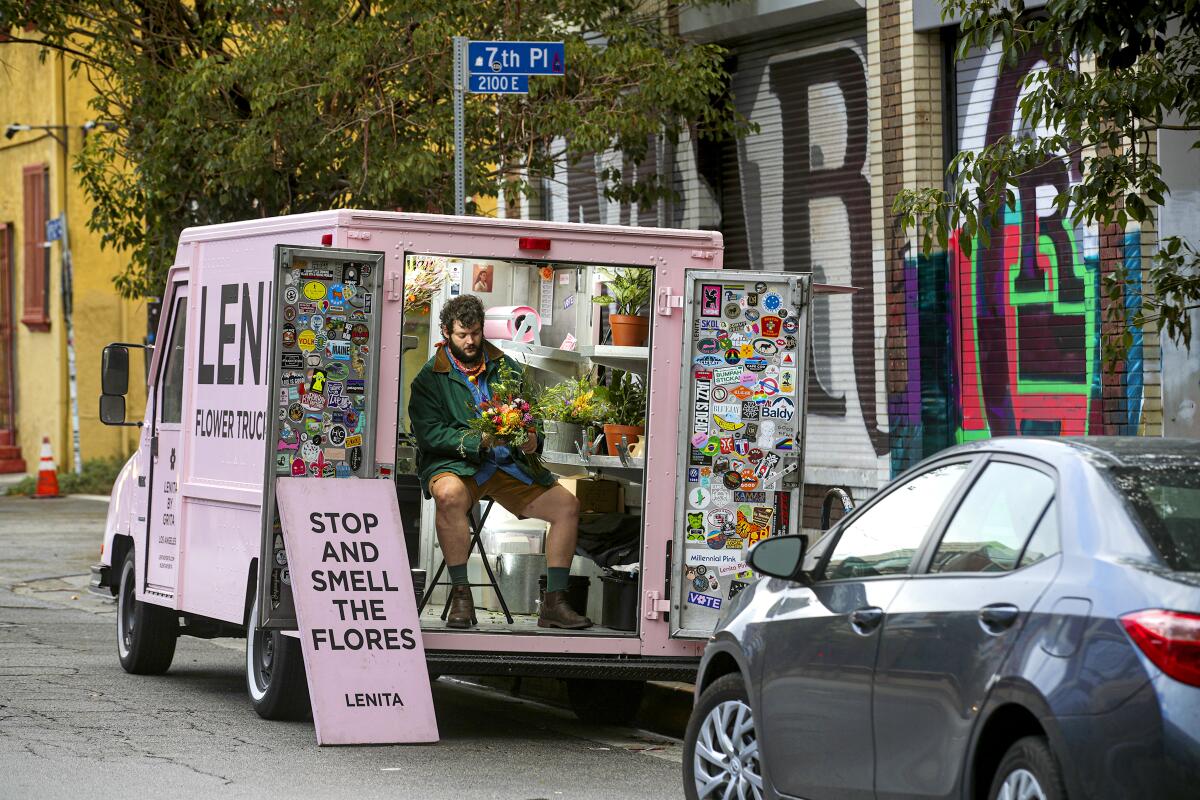
Our latest “Plant PPL” story features Nemuel DePaula, a graphic designer who bought a flower truck on Craigslist and turned a hobby into a successful side business. Now, during the pandemic, his pink truck has become his lifeline.
DePaula is known for his fanciful arrangements featuring wild and otherworldly flowers. He loves to use cockscomb in the fall for its “stunning velvet, brain-like texture,” and the Protea family of flowers, which he describes as “out of this world.”
His mobile florist shop, which he named Lenita by Grita after his mother, was inspired by L.A.’s ubiquitous food trucks. DePaula attributes its recent success to the slower, more deliberate pace of pandemic life.
Customers are “more aware of what they spend their money on right now. They want to support small businesses. They realize that there is a chain of people they support when they buy my plants — farmers, growers, vendors at the flower mart.”
Our reporters covering the coronavirus outbreak want to hear from you. Email us your questions, and we’ll do our best to answer them. You can find more answers in our Frequently Asked Questions roundup and in our reopening tracker.
For the most up-to-date coronavirus coverage from The Times over the weekend, visit our homepage and our Health section, sign up for our breaking news alerts, and follow us on Twitter and on Instagram.




